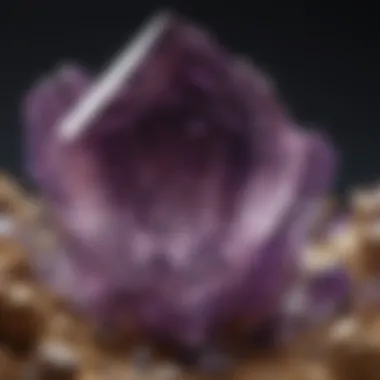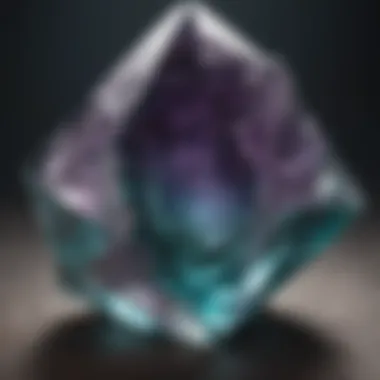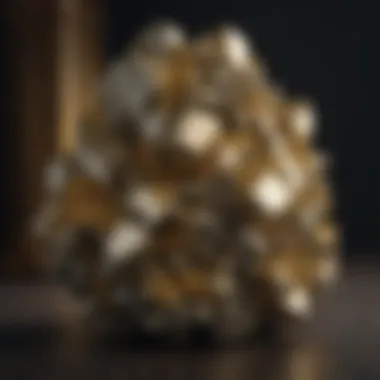Unveiling the Marvels of Unique Mineral Specimens for Sale


Rock and Fossil Identification
Collecting Tips and Techniques
For avid collectors seeking to enhance their mineral specimen collection, mastering the best practices for collecting is indispensable. From selecting prime collecting sites abundant with unique geological treasures to safely extracting specimens without causing damage to the surrounding environment or the specimens themselves, collectors must adhere to ethical guidelines and conservation principles. By honing their skills in effectively locating and excavating mineral specimens, enthusiasts can elevate their collection with rare and remarkable finds. Implementing proper techniques for handling and transporting specimens ensures their preservation for future generations to enjoy.
Preservation and Display
Preserving and displaying rock and fossil specimens is an art form that requires attention to detail and creativity. To maintain the integrity of collected specimens, collectors must employ various preservation techniques, such as cleaning methods and protective coatings, to prevent deterioration over time. Proper storage methods, including utilizing archival-quality containers and humidity-controlled environments, safeguard specimens from external factors that could compromise their condition. When it comes to showcasing these geological marvels, collectors can explore creative display ideas that not only highlight the beauty of each specimen but also educate and inspire viewers about the wonders of the natural world.
Geological Insights
Delving deeper into the world of unique mineral specimens unveils a wealth of geological insights waiting to be discovered. By exploring the geological formations and processes that give rise to rocks and fossils, collectors gain a deeper appreciation for the Earth's complex history and the forces that shape its landscapes. Moreover, recognizing the historical significance of rocks and fossils opens a window into the past, shedding light on ancient environments and life forms that once inhabited the planet. Keeping abreast of notable discoveries in the field propels collectors into the forefront of new findings and advances in our understanding of the Earth's geological heritage.
Introduction to Mineral Specimens
In the vast world of geological wonders, mineral specimens hold a unique allure that captivates both collectors and enthusiasts. The introduction to mineral specimens sets the foundation for exploring these natural treasures available for sale. From rare crystals to exceptional formations, this introductory section serves as a gateway into the diverse market of geological marvels. By highlighting the key points that will be discussed and the relevance of the topic, readers are primed to delve deeper into the realm of unique mineral specimens.
Understanding Mineral Specimens
The Definition of Mineral Specimens
The definition of mineral specimens lies at the core of understanding these geological wonders. Defined as naturally occurring inorganic substances with a specific chemical composition and crystalline structure, mineral specimens offer a glimpse into Earth's geological history. Their contribution to the overall topic is paramount, serving as tangible examples of the Earth's mineralogical diversity. The key characteristic of mineral specimens is their crystalline nature, which distinguishes them from other geological materials. This feature makes mineral specimens a popular choice for collectors and enthusiasts alike, seeking to witness the intricate beauty of natural formations. While the uniqueness of each specimen adds to their appeal, the challenge lies in the delicate handling required to preserve their structure and beauty.
Types of Mineral Formations
Types of mineral formations encompass a wide variety of geological structures, each with its own distinctive characteristics. From crystalline aggregates to massive mineral deposits, the diversity in formations offers a rich tapestry for collectors to explore. By highlighting the key characteristics of different mineral formations, enthusiasts gain insight into the vast array of geological treasures available. This section delves into the advantages and disadvantages of various types of mineral formations in the context of this article, shedding light on the complexities of collecting and appreciating these natural wonders.
Significance of Mineral Specimens
Scientific Importance
The scientific importance of mineral specimens cannot be overstated, serving as valuable tools for geologists, mineralogists, and researchers worldwide. Through detailed analysis of mineral composition and structure, scientists can unravel the Earth's geological processes and history. Their contribution to the overall topic is fundamental, providing a scientific lens through which to view the significance of mineral specimens. The key characteristic of their scientific importance lies in their role as indicators of geological processes and conditions. This unique feature makes mineral specimens a crucial choice for scientific inquiry, driving advancements in our understanding of the Earth's formation and evolution. While their scientific value is undisputed, the challenge lies in ensuring accurate documentation and preservation to retain their research potential.
Collectible Value
The collectible value of mineral specimens transcends their scientific significance, appealing to collectors for their aesthetic and historical worth. As prized possessions sought after by enthusiasts worldwide, mineral specimens hold a special place in the world of collectibles. Their key characteristic lies in their rarity and uniqueness, driving collectors to acquire these geological treasures for their personal collections. This section explores the advantages and disadvantages of collectible value in the context of this article, shedding light on the joys and challenges of acquiring and curating a collection of mineral specimens.


Appeal to Collectors
Aesthetics and Beauty
The aesthetics and beauty of mineral specimens serve as a major draw for collectors, with each specimen showcasing nature's artistic prowess. From vibrant hues to intricate crystal structures, the beauty of mineral specimens mesmerizes collectors and enthusiasts alike. Their key characteristic lies in their visual appeal, enhancing the overall allure of collecting these natural treasures. This section delves into the advantages and disadvantages of aesthetics and beauty in the context of this article, highlighting the subjective nature of beauty in the eyes of collectors.
Rare and Unusual Finds
Rare and unusual finds represent the epitome of collecting mineral specimens, offering collectors the thrill of discovering something truly one-of-a-kind. These unique specimens capture the essence of rarity and intrigue, appealing to collectors who seek the extraordinary in their collections. The key characteristic of rare and unusual finds is their scarcity, making them highly sought after in the market. This section explores the advantages and disadvantages of rare and unusual finds in the context of this article, shedding light on the excitement and challenges of acquiring these exceptional geological marvels.
Factors to Consider When Buying Mineral Specimens
When delving into the world of acquiring mineral specimens, there are crucial factors that collectors and enthusiasts must consider to make informed and rewarding purchases. Understanding these aspects is paramount in enhancing the overall collecting experience and ensuring the authenticity, condition, and value of the specimens. Let's dissect the key elements that outline the significance of Factors to Consider When Buying Mineral Specimens within the context of this comprehensive guide.
Authenticity and Certification
Verified Sources
In the realm of mineral specimens, the concept of verified sources holds immense importance. By sourcing specimens from reputable and recognized providers, collectors can significantly mitigate the risk of acquiring counterfeit or misrepresented items. Trusting verified sources provides assurance regarding the authenticity and integrity of the specimen, instilling confidence in the buyer. The distinctive characteristic of verified sources lies in their rigorous processes for verifying the origins and characteristics of each specimen, ensuring transparency and credibility in the transaction. While the primary advantage of verified sources is the reliability they offer in authentic specimens, one of the potential disadvantages could be the higher initial cost associated with obtaining specimens from established sources.
Certification Standards
Certification standards play a vital role in confirming the quality and authenticity of mineral specimens. These standardized protocols provide a universal benchmark for evaluating the origin, composition, and overall value of a specimen. Adhering to certification standards not only safeguards collectors against fraudulent practices but also facilitates comparability and trust within the market. The unique feature of certification standards lies in their ability to set industry-wide guidelines that promote professionalism and consistency across transactions. While the primary advantage of certification standards is the assurance they provide in the quality and integrity of specimens, one possible drawback could be the additional time and effort required to meet stringent certification criteria.
Condition and Preservation
Damage Assessment
Assessing the condition of mineral specimens is imperative in gauging their value and long-term preservation. Conducting a meticulous damage assessment allows collectors to identify any flaws, fractures, or weaknesses in the specimen, guiding them in making informed decisions on restoration, display, or storage options. The key characteristic of damage assessment is its role in indicating the overall health and durability of a specimen, influencing its aesthetic appeal and investment potential. While the benefit of damage assessment lies in promoting proactive care and maintenance of specimens, a disadvantage could be the subjective nature of assessing damage levels across different collectors.
Storage and Display
Efficient storage and captivating display are essential components of maintaining the condition and visual impact of mineral specimens. Proper storage methods, such as utilizing acid-free containers or humidity-controlled environments, safeguard specimens from deterioration or discolouration over time. Effective display techniques enhance the aesthetic appeal of specimens, allowing their unique features to be showcased and appreciated. The key characteristic of storage and display is their ability to prolong the lifespan and attractiveness of specimens, preserving their intrinsic beauty and historical significance. While the advantage of storage and display is evident in preserving the specimens' quality and value, a potential disadvantage could be the space and resources required to implement elaborate preservation methods.
Market Value and Pricing
Factors Affecting Price


An integral aspect of buying mineral specimens is understanding the factors that influence their pricing in the market. Various elements, including rarity, size, provenance, and aesthetic qualities, contribute to determining the value and desirability of specimens. Recognizing these factors empowers collectors to make informed decisions based on the intrinsic and extrinsic characteristics of the specimens. The unique feature of factors affecting price lies in their dynamic and multifaceted nature, reflecting the intricate interplay between geological significance, market demand, and supply dynamics. While the advantage of understanding these factors is the ability to discern fair market values, a potential disadvantage could be the fluctuating and sometimes speculative nature of pricing determinants.
Investment Potential
For avid collectors and investors, appraising the investment potential of mineral specimens is a key consideration. Specimens with historical significance, rarity, or unique attributes may appreciate in value over time, presenting opportunities for lucrative returns or diversification of portfolios. Evaluating the investment potential involves conducting thorough research, seeking expert advice, and considering the long-term market trends within the mineral specimen industry. The distinct characteristic of investment potential lies in its capacity to combine passion for collecting with strategic financial decisions, offering both enjoyment and potential financial gains. While the advantage of exploring investment potential is the possibility of acquiring specimens with appreciating values, a potential disadvantage could be the unpredictable nature of markets and changing collector preferences.
Exploring Available Mineral Specimens
In the context of this article on mineral specimens, exploring the available options holds immense significance. Delving into the diverse world of mineral specimens allows collectors and enthusiasts to discover rare crystals, unique formations, and geological treasures. This exploration provides an opportunity to appreciate the beauty and intricacies of nature while enhancing one's collection. By understanding the various types and categories of mineral specimens available for sale, individuals can broaden their knowledge and appreciation for the Earth's geological wonders.
Types of Mineral Specimens
Crystals and Gemstones
Crystals and gemstones are coveted for their stunning aesthetics and metaphysical properties. In the realm of mineral specimens, crystals and gemstones play a vital role in attracting collectors due to their vibrant colors, unique formations, and healing energies. These specimens are highly valued for their rarity, clarity, and brilliance, making them desirable additions to any collection. While their beauty is a major draw, collectors also appreciate the metaphysical benefits that crystals and gemstones are believed to offer.
Geodes and Fossils
Geodes and fossils hold a special place in the world of mineral specimens for their archaeological and historical significance. Geodes, with their hollow cavity lined with crystals, are sought after for their natural beauty and fascinating interiors. Fossils, on the other hand, provide a glimpse into the Earth's ancient past, showcasing the remains of prehistoric plants and animals preserved in stone. These specimens appeal to collectors interested in paleontology and the earth's evolutionary history.
Rare Earth Minerals
Rare earth minerals are prized for their scarcity and unique chemical composition. These minerals are essential in various industries, including technology, due to their magnetic, luminescent, and conductive properties. In the realm of mineral collecting, rare earth minerals offer collectors the opportunity to own pieces of the Earth's crust that are not only valuable but also scientifically intriguing. Their limited availability and diverse range make them sought-after specimens for those looking to diversify their collection with rare and exotic minerals.
Popular Mineral Specimen Categories
Quartz Varieties
Quartz varieties are among the most popular mineral specimens due to their abundance and diverse colors. From clear quartz to amethyst and citrine, quartz specimens are known for their beauty, versatility, and metaphysical properties. Collectors are drawn to quartz varieties for their affordability and the wide array of formations available, making them a staple in any mineral collection.
Fluorescent Minerals
Fluorescent minerals exhibit a unique optical phenomenon where they emit visible light when exposed to ultraviolet light. These specimens captivate collectors with their vibrant glow and otherworldly appearance under UV light. Fluorescent minerals are prized for their rarity and distinctive fluorescence patterns, adding a dynamic and colorful dimension to any mineral collection.
Metallic Ores
Metallic ores encompass a range of minerals valued for their metallic luster and economic importance. These minerals, including hematite, pyrite, and galena, are sought after for their role in industrial applications and their striking appearance. Collectors interested in minerals with a metallic sheen are drawn to metallic ores for their aesthetic value and the historical significance of mining and metallurgy.


Noteworthy Specimens for Sale
Exceptional Crystalline Structures
Exceptional crystalline structures represent the epitome of mineral perfection, boasting flawless crystal formations and exceptional clarity. These specimens are highly prized for their aesthetic appeal and structural complexity, showcasing the natural beauty of crystalline growth. Collectors seeking rare and exceptional pieces often gravitate towards crystalline structures for their visual impact and intrinsic beauty.
Unique Geological Formations
Unique geological formations encompass a diverse range of specimens that showcase the Earth's geological processes and history. From intricate stalactites to colorful banded agates, these formations offer a glimpse into the dynamic forces that shape our planet. Collectors with a passion for geology and earth sciences are drawn to unique geological formations for their educational value and the opportunity to own a piece of Earth's geological heritage.
Tips for Buying Mineral Specimens
In this article, the section on 'Tips for Buying Mineral Specimens' serves as a crucial guide for enthusiasts looking to acquire unique mineral specimens. It emphasizes the importance of conducting thorough research and being well-informed before making any purchase. By outlining specific elements such as authenticity checks, market trends, and pricing considerations, readers can make informed decisions about their acquisitions. Understanding the significance of provenance and certification adds value to the collector's overall experience and investment strategy.
Research and Education
Understanding Collecting Trends
Understanding Collecting Trends plays a pivotal role in guiding collectors towards making informed decisions about acquiring mineral specimens. By staying abreast of current market preferences and emerging collecting patterns, enthusiasts can enhance their collection portfolios and anticipate potential investment opportunities. This section details the importance of recognizing shifts in collecting trends as a valuable tool for identifying valuable specimens and maximizing the overall collecting experience. Understanding the nuances of audience preferences and evolving tastes equips collectors with a strategic advantage in their acquisition pursuits.
Geological Knowledge
Geological Knowledge is a fundamental aspect of acquiring mineral specimens, providing collectors with essential insights into mineral formation, rarity, and geological significance. This knowledge empowers collectors to appreciate the geological history behind each specimen, fostering a deeper connection to the Earth's natural processes. By understanding the geological context of specimens, collectors can make informed choices, assess quality, and determine the long-term value of their acquisitions.
Establishing Trustworthy Relationships
Reputable Dealers
Establishing relationships with Reputable Dealers is crucial for collectors seeking high-quality and authentic mineral specimens. Trusted dealers offer transparency, expertise, and credibility, ensuring that collectors make informed decisions based on accurate information. This section emphasizes the importance of building trust with reputable dealers to access a diverse range of specimens backed by reliable certifications and assurances of quality.
Community Recommendations
Community Recommendations provide valuable insights and peer reviews within the collecting community, offering guidance on reputable dealers, quality specimens, and ethical collecting practices. Leveraging community recommendations enhances the collector's ability to navigate the market effectively, connect with like-minded enthusiasts, and build a network of trusted sources for acquiring and evaluating mineral specimens.
Care and Maintenance
Cleaning Techniques
Effective Cleaning Techniques are essential for preserving the beauty and integrity of mineral specimens. Proper cleaning methods ensure the removal of dirt, oils, and contaminants without damaging the specimen's natural features. This section details the importance of gentle cleaning approaches, suitable cleaning agents, and precautions to safeguard the specimen's physical and chemical properties.
Long-Term Preservation
Long-Term Preservation strategies are vital to maintaining the condition and value of mineral specimens over time. By implementing proper storage, display, and environmental controls, collectors can prevent deterioration, protect against damage, and preserve the specimens for future generations. Understanding the unique preservation needs of different mineral types is essential for safeguarding the integrity and beauty of the collection.







